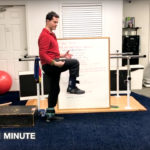I thought I was going to have to spend hours cranking out several miles on the treadmill in order to train for my upcoming Kilimanjaro trek, which was not a thrilling prospect for me, to say the least! But after working with Fit For Trips on a customized training program, I learned there is more to training for Kilimanjaro than I originally thought. My program incorporates cardio, strength and endurance training via a variety of exercises. I really like having a specific workout plan each time I go to the gym; it has been keeping me focused and makes me very confident I’ll be properly prepared for Kilimanjaro’s Western Approach in August.
 This photo of Kili’s Furtwangler Glacier is posted at my desk, right by my computer. Just the thought seeing these glaciers in person keeps me motivated as work through my training regimen.
This photo of Kili’s Furtwangler Glacier is posted at my desk, right by my computer. Just the thought seeing these glaciers in person keeps me motivated as work through my training regimen.
What about the dreaded treadmill, you ask? Well, it is still a part of my workout regimen – it’s a necessary evil, I guess! However I’ve learned that running on the treadmill isn’t the most efficient way to train for Kilimanjaro. Believe it or not, to train for Kili, you need to practice walking! Slowing the treadmill down to a walking pace (and at a steep grade) was counter-intuitive to me at first but now I can see that it’s the closest thing to being on the trail. I’ve recently increased the intensity of my treadmill workouts by wearing a weighted backpack…yes, I’ve received a bunch of curious looks from others at my gym as I’m stomping up the treadmill with a bag of weights on my back but the benefits far outweigh the initial awkwardness.
My stair workouts have been great too. Instead of doing this on a Stairmaster, I prefer 8-10 minute sets on a single flight of stairs because it not only forces me to focus and puts me into the zone but it also gives me the opportunity to train for the descent… don’t forget, you have to walk down several thousand feet from the summit! I hear the descent can be tough on your knees, so I’m definitely taking the time to strengthen the muscles to support my joints. Upgrading to a larger flight of stairs is on my to-do list!
I have terrible balance so one of the most challenging exercises for me is the sideward bound-pause. When I try to do it, it is more like “sideward bound-hop-wobble-hop.” Watch how it is done in the Fit For Trips clip below; it’s not easy!
As a swimmer, I’ve never had to work the smaller, stabilizing muscles in my hips, knees and ankles but these small muscles are the key to keep me from stumbling over rocks and roots on the trail and will help to reduce the risk of injury. As they say, practice makes perfect, and the more I practice the sideward bound-pause, the less I’ve been wobbling on the pauses.
I figure this trek will also challenge my mental fitness, so I placed a photo (the one of the Furtwangler Glaciers at the top of the post) at my desk to keep me focused on my goal. It is helping me visualize the moment when I will finally take a stroll amongst the famous glaciers of Kilimanjaro. I can’t wait!
–
Route-specific training programs set up by Fit For Trips for Thomson Safaris’ Kilimanjaro treks. Custom programs are built with individuals’ fitness level and lifestyle in mind.
Look for more posts as we follow Rachel through her training program. If you’ve climbed Kili before, wish her luck, share a story or offer words of wisdom via posting a comment below!






